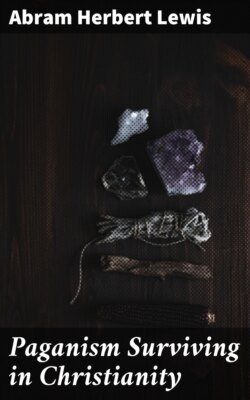Читать книгу Paganism Surviving in Christianity - Abram Herbert Lewis - Страница 10
На сайте Литреса книга снята с продажи.
This Method Opposed by Some.
ОглавлениеTable of Contents
Some of the early Fathers, those who were least tinctured with Greek thought, especially Tertullian, opposed this method at the first. He declared that it was one of the arts of Satan, against which Christians must wrestle. But the system was too deep-seated in all the prevailing currents of influence to be displaced. Even while Tertullian was opposing it, it was tightening its grasp upon the Christian communities; a grasp which is by no means yet removed. Starting first at Alexandria and strengthened by the union of Greek philosophy and Hebrew theology, it gathered force like an increasing tide, and overwhelmed all other forms of exegesis. A pertinent example is found in Clement of Alexandria, in a philippic against the Sophists:
“Look to the tongue and to the words of the glozing man,
But you look on no work that has been done;
But each one of you walks in the steps of a fox,
And in all of you is an empty mind.”
Clement of Alexandria comments on this as follows:
“This, I think, is signified by the utterance of the Saviour, ‘The foxes have holes, but the Son of man hath not where to lay his head.’ For on the believer alone, who is separated entirely from the rest, who by the Scripture are called wild beasts, rests the head of the universe, the kind and gentle Word, ‘Who taketh the wise in their own craftiness. For the Lord knoweth the thoughts of the wise, that they are vain’; the Scripture calling those the wise (σοφοὺς) who are skilled in words and arts, sophists (σοφιστὰς).”[43]
In another place the story of the feeding of the multitude by Christ is explained in these words:
“And the Lord fed the multitude of those that reclined on the grass opposite to Tiberias with the two fishes and the five barley loaves, indicating the preparatory training of the Greeks and Jews previous to the divine grain, which is the food cultivated by the law. For barley is sooner ripe for the harvest than wheat; and the fishes signified the Hellenic philosophy that was produced and moved in the midst of the Gentile billow, given, as they were, for copious food to those lying on the ground, increasing no more, like the fragments of the loaves, but having partaken of the Lord’s blessing, had breathed into them the resurrection of God-head through the power of the Word. But if you are curious, understand one of the fishes to mean the curriculum of study, and the other the philosophy which supervenes. The gatherings point out the word of the Lord.”[44]
Christianity, according to the New Testament, could not be developed under such exegesis. These pagano-Christian leaders had still greater love for the allegorical method because it enabled them to “explain away” the difficulties which they found in considering Christianity—as they conceived of it—to be the product of the Old Testament. From the first they had identified the God of the Old Testament with the Demiurge, the creator of the world and of matter, in which was only evil. They claimed that Jehovah could not make a revelation for all time, nor one worthy of their confidence. Hatch, speaking of the Old Testament, says:
“An important section of the Christian world rejected its authority altogether; it was the work, not of God, but of His rival, the god of this world; the contrast between the Old Testament and the New was part of the larger contrast between matter and spirit, darkness and light, evil and good. This was the contention of Marcion, whose influence upon the Christian world was far larger than is commonly supposed.”[45]
